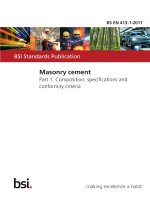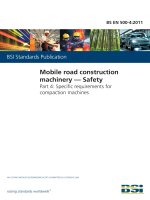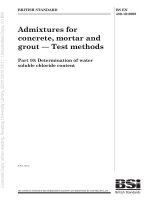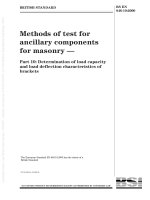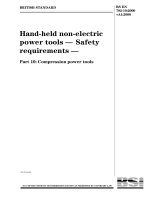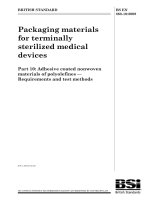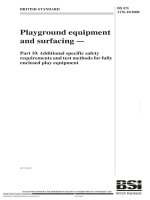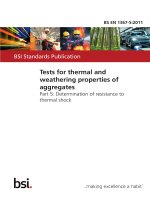Bsi bs en 61937 10 2011
Bạn đang xem bản rút gọn của tài liệu. Xem và tải ngay bản đầy đủ của tài liệu tại đây (1.17 MB, 20 trang )
BS EN 61937-10:2011
Incorporating corrigendum July 2011
BSI Standards Publication
Digital audio — Interface
for non-linear PCM encoded
audio bitstreams applying
IEC 60958
Part 10: Non-linear PCM bitstreams according
to the MPEG-4 Audio Lossless Coding (ALS)
format
BRITISH STANDARD
BS EN 61937-10:2011
National foreword
This British Standard is the UK implementation of EN 61937-10:2011. It
supersedes BS IEC 61937-10:2011, which is withdrawn.
The UK participation in its preparation was entrusted to Technical Committee
EPL/100, Audio, video and multimedia systems and equipment.
A list of organizations represented on this committee can be obtained
on request to its secretary.
This publication does not purport to include all the necessary provisions of
a contract. Users are responsible for its correct application.
© BSI 2011
ISBN 978 0 580 76292 5
ICS 33.160.30; 35.240.99
Compliance with a British Standard cannot confer immunity from legal
obligations.
This British Standard was published under the authority of the Standards
Policy and Strategy Committee on 31 August 2011.
Amendments/Corrigendum issued since publication
Date
31 July 2011
Text affected
Renumbers BS IEC 61937-10:2011 as BS EN
61937-10: 2011
BS EN 61937-10:2011
EUROPEAN STANDARD
EN 61937-10
NORME EUROPÉENNE
June 2011
EUROPÄISCHE NORM
ICS 33.160.30; 35.240.99
English version
Digital audio Interface for non-linear PCM encoded audio bitstreams applying IEC
60958 Part 10: Non-linear PCM bitstreams according to the MPEG-4 Audio
Lossless Coding (ALS) format
(IEC 61937-10:2011)
Audionumérique Interface pour les flux de bits audio à
codage MIC non linéaire conformément à
la CEI 60958 Partie 10: Flux de bits à codage MIC nonlinéaire selon le format MPEG-4 Audio
sans perte (Audio Lossless Coding ALS)
(CEI 61937-10:2011)
Digitalton Schnittstelle für nichtlinear-PCM-codierte
Audio-Bitströme unter Verwendung von
IEC 60958 Teil 10: Nichtlineare PCM-Bitströme
entsprechend dem Format MPEG-4-ALS
(verlustfreie Audiodatenkompression)
(IEC 61937-10:2011)
This European Standard was approved by CENELEC on 2011-05-25. CENELEC members are bound to comply
with the CEN/CENELEC Internal Regulations which stipulate the conditions for giving this European Standard
the status of a national standard without any alteration.
Up-to-date lists and bibliographical references concerning such national standards may be obtained on
application to the Central Secretariat or to any CENELEC member.
This European Standard exists in three official versions (English, French, German). A version in any other
language made by translation under the responsibility of a CENELEC member into its own language and notified
to the Central Secretariat has the same status as the official versions.
CENELEC members are the national electrotechnical committees of Austria, Belgium, Bulgaria, Croatia, Cyprus,
the Czech Republic, Denmark, Estonia, Finland, France, Germany, Greece, Hungary, Iceland, Ireland, Italy,
Latvia, Lithuania, Luxembourg, Malta, the Netherlands, Norway, Poland, Portugal, Romania, Slovakia, Slovenia,
Spain, Sweden, Switzerland and the United Kingdom.
CENELEC
European Committee for Electrotechnical Standardization
Comité Européen de Normalisation Electrotechnique
Europäisches Komitee für Elektrotechnische Normung
Management Centre: Avenue Marnix 17, B - 1000 Brussels
© 2011 CENELEC -
All rights of exploitation in any form and by any means reserved worldwide for CENELEC members.
Ref. No. EN 61937-10:2011 E
BS EN 61937-10:2011
EN 61937-10:2011
-2-
Foreword
The text of document 100/1733/CDV, future edition 1 of IEC 61937-10, prepared by technical area 4,
Digital system interfaces and protocols, of IEC TC 100, Audio, video and multimedia systems and
equipment, was submitted to the IEC-CENELEC parallel vote and was approved by CENELEC as
EN 61937-10 on 2011-05-25.
Attention is drawn to the possibility that some of the elements of this document may be the subject of
patent rights. CEN and CENELEC shall not be held responsible for identifying any or all such patent
rights.
The following dates were fixed:
– latest date by which the EN has to be implemented
at national level by publication of an identical
national standard or by endorsement
(dop)
2012-02-25
– latest date by which the national standards conflicting
with the EN have to be withdrawn
(dow)
2014-05-25
Annex ZA has been added by CENELEC.
__________
Endorsement notice
The text of the International Standard IEC 61937-10:2011 was approved by CENELEC as a European
Standard without any modification.
In the official version, for Bibliography, the following note has to be added for the standard indicated:
IEC 60958-3
NOTE Harmonized as EN 60958-3.
__________
BS EN 61937-10:2011
EN 61937-10:2011
-3-
Annex ZA
(normative)
Normative references to international publications
with their corresponding European publications
The following referenced documents are indispensable for the application of this document. For dated
references, only the edition cited applies. For undated references, the latest edition of the referenced
document (including any amendments) applies.
NOTE When an international publication has been modified by common modifications, indicated by (mod), the relevant EN/HD
applies.
Publication
Year
IEC 60958
Title
EN/HD
Year
Series Digital audio interface
EN 60958
Series
IEC 61937
Series Digital audio - Interface for non-linear PCM
encoded audio bitstreams applying IEC 60958
EN 61937
Series
IEC 61937-1
-
Digital audio - Interface for non-linear PCM
encoded audio bitstreams applying IEC 60958
- Part 1: General
EN 61937-1
-
IEC 61937-2
-
Digital audio - Interface for non-linear PCM
encoded audio bitstreams applying IEC 60958
- Part 2: Burst-info
EN 61937-2
-
ISO/IEC 14496-3
+ A2
2009
2010
Information technology - Coding of audiovisual objects - Part 3: Audio
-
-
BS EN 61937-10:2011
–2–
EN 61937-10:2011
CONTENTS
1
Scope ............................................................................................................................... 5
2
Normative references ....................................................................................................... 5
3
Terms, definitions, abbreviations and conventions ............................................................ 5
4
3.1 Terms and definitions .............................................................................................. 5
3.2 Abbreviations .......................................................................................................... 6
3.3 Presentation convention .......................................................................................... 6
Mapping of the audio bitstream onto IEC 61937 ............................................................... 6
5
4.1 General ................................................................................................................... 6
4.2 MPEG-4 ALS burst-info ........................................................................................... 6
Format of MPEG-4 ALS data-bursts .................................................................................. 7
5.1
5.2
General ................................................................................................................... 7
Audio data-bursts .................................................................................................... 7
5.2.1 Data-burst for MPEG-4 ALS ......................................................................... 7
5.2.2 Latency of MPEG-4 ALS decoding ............................................................... 9
Annex A (informative) Effect of repetition period of data-burst and IEC 60958 frame
rate on frame period for the MPEG-4 ALS bitstreams ............................................................ 11
Annex B (normative) Burst payload format for MPEG-4 ALS ................................................ 12
Annex C (normative) Values for ALSSpecificConfig in the MPEG-4 ALS burst payload
format ................................................................................................................................... 13
Bibliography .......................................................................................................................... 15
Figure 1 – MPEG-4 ALS data-burst ......................................................................................... 8
Figure 2 – Latency of MPEG-4 ALS decoding ......................................................................... 9
Figure 3 – The MPEG-4 ALS burst-payload............................................................................. 9
Figure B.1 – MPEG-4 ALS burst-payload .............................................................................. 12
Table 1 – Fields of burst-info (data-type=23, sub-data-type=0) ............................................... 7
Table 2 – Sample rate and number of channels of MPEG-4 ALS encoded audio,
multiplier, and IEC 60958 frame rate ....................................................................................... 9
Table A.1 – MPEG-4 ALS payload and frame repetition: some examples .............................. 11
Table C.1 – Recommended values for the ALSSpecificConfig in the MPEG-4 ALS
burst-payload ........................................................................................................................ 13
BS EN 61937-10:2011
EN 61937-10:2011
–5–
DIGITAL AUDIO –
INTERFACE FOR NON-LINEAR PCM ENCODED
AUDIO BITSTREAMS APPLYING IEC 60958 –
Part 10: Non-linear PCM bitstreams according
to the MPEG-4 audio lossless coding (ALS) format
1
Scope
This part of IEC 61937 specifies the method for IEC 60958 to convey non-linear PCM
bitstreams encoded in accordance with the MPEG-4 audio lossless coding (ALS) format.
2
Normative references
The following referenced documents are indispensable for the application of this document.
For dated references, only the edition cited applies. For undated references, the latest edition
of the referenced document (including any amendments) applies.
IEC 60958 (all parts),
Digital audio interface
IEC 61937 (all parts),
applying IEC 60958
Digital audio – Interface for non-linear PCM encoded audio bitstreams
IEC 61937-1, Digital audio – Interface for non-linear PCM encoded audio bitstreams
applying IEC 60958 – Part 1: General
IEC 61937-2, Digital audio – Interface for non-linear PCM encoded audio bitstreams
applying IEC 60958 – Part 2: Burst-Info
ISO/IEC 14496-3:2009,
Audio
Amendment 2:2010,
3
Information technology – Coding of audio-visual objects – Part 3:
ALS Simple Profile and Transport of SAOC
Terms, definitions, abbreviations and conventions
For the purposes of this document, the following terms and definitions, abbreviations and
presentation conventions apply.
3.1
Terms and definitions
3.1.1
sub data-type
reference to the type of payload of the data-burst defined for use with the specified data-type
3.1.2
latency
delay time of an external audio decoder to decode a MPEG-4 ALS data-burst, defined as the
sum of the receiving delay time and the decoding delay time
3.1.2
length code
code indicating the length of the data-burst-payload in 8-byte units according to this standard
BS EN 61937-10:2011
–6–
EN 61937-10:2011
3.1.4
als_id
ALS identifier in ALSSpecificConfig
3.1.5
samp_freq
sampling frequency of the audio samples contained in the MPEG-4 ALS burst payload
3.1.6
samples
number of audio samples per channel contained in the MPEG-4 ALS burst payload
NOTE In contrast to the ALS specification, each data-burst provides its own ALSSpecificConfig. Thus the
'samples' value refers to the total number of samples (per channel) of that data-burst.
3.1.7
channels
number of channels-1, 'channels', contained in the MPEG-4 ALS burst payload
3.1.8
resolution
bit depth of the audio samples contained in the MPEG-4 ALS burst payload
3.1.9
aux_size
size of the auxiliary data field in bytes for MPEG-4 ALS
3.1.10
aux_data
auxiliary data contained in the MPEG-4 ALS burst payload
NOTE
Not required for decoding audio samples.
3.2
Abbreviations
ALS
Audio Lossless Coding
PCM
Pulse-Code Modulation
3.3
Presentation convention
01 2
4
4.1
Value “01” in binary format
Mapping of the audio bitstream onto IEC 61937
General
The coding of the bitstream and data-burst is in accordance with the IEC 61937 series of
standards.
4.2
MPEG-4 ALS burst-info
The 16-bit burst-info contains information about the data that will be found in the data-burst in
accordance with Table 1.
BS EN 61937-10:2011
EN 61937-10:2011
–7–
Table 1 – Fields of burst-info (data-type=23, sub-data-type=0)
Bits of
Pc
Value
0 to 4
23
24-31
5, 6
Repetition period of
data-burst in
IEC 60958 frames
Bit 0 of Pa
See 5.2.1
In accordance with IEC 61937-2
MPEG-4 ALS or other applications according to
IEC 61937-2, depending on sub-data-type
In accordance with IEC 61937-2
sub data-type
0
1-3
MPEG-4 ALS
See 5.2.1
In accordance with IEC 61937-2
0
Error-flag indicating a valid burst-payload
1
Burst may contain errors
8 to 12
Data-type and sub-data-type dependent
information for MPEG-4 ALS
8
Multiplier
9 to 12
0
[IEC 60958 frame rate] = audio sampling rate × 2
1
[IEC 60958 frame rate] = audio sampling rate × 8
0000
No indication
0001
ALS Simple Profile Level 1
00101111
Reserved for future Profile or Level
13 to 15
5
Reference
point R
data-type
0-22
7
Contents
In accordance with IEC 61937-1 and
IEC 61937-2.
Format of MPEG-4 ALS data-bursts
5.1
General
This clause specifies the audio data-burst MPEG-4 ALS. Specific properties, such as
reference points, repetition period, the method of filling stream gaps, and decoding latency,
are specified for each data-type.
The decoding latency (or delay), indicated for the data-types, should be used by the
transmitter to schedule data-bursts, as necessary, to establish synchronisation between video
and decoded audio.
5.2
5.2.1
Audio data-bursts
Data-burst for MPEG-4 ALS
Figure 1 shows the detailed description of the MPEG-4 ALS data-burst. The stream of the
data-bursts for MPEG-4 ALS consists of sequences of MPEG-4 ALS bitstreams. The datatype of a MPEG-4 ALS data-burst is 23. The sub data-type is 0. The data-burst is headed with
a burst-preamble, followed by the burst-payload, and stuffed with stuffing bits. The burstpayload of each data-burst of MPEG-4 ALS data shall contain an ALSSpecificConfig header,
and one or more ALS random access units. Each data-burst constitutes a self-contained ALS
bitstream, whose number of samples (per channel) is given in the field 'samples' of (the
corresponding) ALSSpecificConfig. The units of length-code (burst_length) shall be in 8-bytes.
BS EN 61937-10:2011
–8–
EN 61937-10:2011
Note that if the actual data size of the data-burst is not a multiple of 8 bytes, 1 to 7 stuffing
bytes are included in the burst_length.
The number of samples for each encoded channel contained in the data-burst are indicated in the
encoded ALS bitstream. The length of the MPEG-4 ALS data-burst depends on the encoded bit rate
(which determines the MPEG-4 ALS frame length). For details, see Annex B.
The reference to the specification for the MPEG-4 ALS bitstream, representing the number
of samples of encoded audio per frame, may be found in ISO/IEC 14496-3, subpart 11.
Pa Pb Pc Pd
MPEG-4 ALS
burst-payload
Pa Pb Pc Pd
MPEG-4 ALS
burst-payload
Bit 0 of Pa
Bit 0 of Pa
MPEG-4 ALS frame
Stuffing
MPEG-4 ALS frame
Regular rate of the MPEG- 4 ALS frames
Repetition period of the burst
IEC
708/11
Figure 1 – MPEG-4 ALS data-burst
The regular rate of the MPEG-4 ALS frames and the repetition period of the data burst can be
calculated as
'[samples] × [IEC 60958 frame rate]/[sampling frequency of the encoded audio samples
(samp_freq)]'.
The value of the 'samples' field is stored in the 9th to 12th bytes of the MPEG-4 ALS burstpayload. The value represents the number of samples contained in the MPEG-4 ALS burstpayload. The IEC 60958 frame rate is defined by the audio sampling rate and a value of the
multiplier (see Table.2).
The reference point of a MPEG-4 ALS data-burst is bit 0 of Pa and occurs exactly once every
predefined number of IEC 60958 frames. The data-burst containing MPEG-4 ALS frames shall
occur at a regular rate, with the reference point of each MPEG-4 ALS data-burst beginning
after the number of IEC 60958 frames in the previous MPEG-4 ALS data-burst from the
reference point of the preceding MPEG-4 ALS data-burst (of the same bit-stream-number).
It is recommended that pause data-bursts be used to fill stream gaps in the MPEG-4 ALS bit
stream as described in the IEC 61937-1, and that pause data-bursts be transmitted with a
repetition period of 32 IEC 60958 frames, except when other repetition periods are necessary
to fill the precise stream gap length (which may not be a multiple of 32 IEC 60958 frames), or
to meet the requirement on burst spacing (see IEC 61937-1).
When a stream gap in an MPEG-4 ALS stream is filled by a sequence of pause data-bursts,
the Pa of the first pause data-burst shall be located after a number of sampling periods
represented by the 'samples' field of the ALSSpecificConfig header in the previous MEG-4
ALS data-burst from the Pa of the previous MPEG-4 ALS frame. It is also recommended that
the sequence(s) of pause data-bursts that fill the stream gap should continue from this point
up to (as close as possible, considering the 32 IEC 60958 frame length of the pause databurst) the Pa of the first MPEG-4 ALS data-burst that follows the stream gap. The MPEG-4
ALS decoder can detect the number of decoded PCM samples by using the value set in the
'samples' field of ALSSpecificConfig.
BS EN 61937-10:2011
EN 61937-10:2011
–9–
Table 2 shows the relation between the sample rate of MPEG-4 ALS encoded audio and the
IEC 60958 frame rate used to deliver MPEG-4 ALS encoded audio via the IEC 61937-10
interface.
Table 2 – Sample rate and number of channels of MPEG-4 ALS encoded audio,
multiplier, and IEC 60958 frame rate
Audio sampling rate
kHz
Number of
channels
Multiplier
1, 2
0 (×2)
96
3 to 8
1 (×8)
384
1, 2
0 (×2)
192
3 to 8
1 (×8)
768
1, 2
0 (×2)
384
3 to 8
1 (×8)
1 536
1, 2
0 (×2)
88,2
3 to 8
1 (×8)
352,8
48
96
192
44,1
5.2.2
IEC 60958 frame rate
kHz
Latency of MPEG-4 ALS decoding
The latency of an external audio decoder to decode MPEG-4 ALS is defined as the sum of the
receiving delay time and the decoding delay time as shown in Figure 2.
MPEG-4 ALS
burst- payload
Pa Pb Pc Pd
Bit 0 of Pa
MPEG-4 ALS
burst -payload
Pa Pb Pc Pd
MPEG-4 ALS frame
Stuffing
Bit 0 of Pa
MPEG-4 ALS frame
Repetition period of the burst
Decoding delay
Receiving delay
Latency of MPEG-4 ALS decoder
IEC
709/11
Figure 2 – Latency of MPEG-4 ALS decoding
Pa Pb Pc Pd
MPEG-4 ALS
burst- payload
Stuffing
Bit 0 of Pa
MPEG-4 ALS
MPEG-4 ALS Random access unit
Nd ALSSpecificConfig
(a frame or frames)
MPEG - 4 ALS frame
IEC
Figure 3 – The MPEG-4 ALS burst-payload
710/11
BS EN 61937-10:2011
– 10 –
EN 61937-10:2011
The receiving delay time to receive a whole data-burst is calculated by using the length of the burstpayload, Nd, which is shown in Figure 3. The length of preamble is 8 bytes. Since an IEC 60958 frame
can contain 4 bytes, the receiving delay of an MPEG-4 ALS data-burst should be as follows:
Receiving delay = (Nd + 8 bytes)/([IEC 60958 frame rate] × 4 bytes)
The maximum receiving delay time is related to the number of samples contained in the data-burst and
th
th
the IEC 60958 frame rate. The number of samples, 'samples', is stored in the 9 to 12 bytes of the
th
th
ALSSpecificConfig header of the MPEG-4 ALS burst-payload (13 to 16 bytes of the MPEG-4 ALS
burst-payload) as shown in Figure 3. The maximum decoding delay time can be regarded as being the
same as the maximum receiving delay time.
Note that the encoded size never exceeds the rate given by the IEC 60958 frame rate in theory except
when the Aux data in burst is too large. The Aux size shall be small enough to ensure that the total size
of the burst complies with following formula:
Pd <= ((([samples]/[samp_freq]) × [IEC 60958 frame rate] × 4 bytes) – 8 bytes)/8
EXAMPLE The maximum size of the MPEG-4 ALS burst-payload shall be equal to or less than the size
calculated by the frame repetition period and the IEC 60958 frame rate. When the values of 'samp_freq',
'samples', 'channels', and 'resolution' are 48 000, 2 048, 1, and 1 respectively, the sampling rate of the
audio signal is 48 kHz, the number of samples contained in the MPEG-4 ALS burst-payload is 2 048
samples, the number of channels is 2 (='channels'+1), and the number of bits per an audio sample is 16
bits. With these values, the IEC 60958 frame rate is 96 kHz as shown in Table 2. Though the receiving
delay time varies depending on the compressed size of the MPEG-4 ALS burst-payload, the maximum
receiving delay time can be calculated by using 'samples' and 'samp_freq'. In this example case, it
should be 42,67 ms (2 048/48 000 = 0,042 67). The maximum decoding delay time should be 42,67 ms
because it can be regarded as being the same as the maximum receiving delay time. The total latency
of MPEG-4 ALS decoding is approximately 85,34 ms.
BS EN 61937-10:2011
EN 61937-10:2011
– 11 –
Annex A
(informative)
Effect of repetition period of data-burst and IEC 60958 frame rate
on frame period for the MPEG-4 ALS bitstreams
Table A.1 shows IEC 60958 frame rates, their repetition period and their frame period in
milliseconds.
Table A.1 – MPEG-4 ALS payload and frame repetition: some examples
Sampling
rate
Frame
repetition
period
IEC 60958 frame rate
Frame period
Fs
ms
44,1 kHz
1 024
88,2 kHz for 2 ch
23,22
2 048
352,8 kHz for 3 to 8 ch
46,44
48 kHz
96 kHz
192 kHz
4 096
92,88
8 192
185,76
1 024
96 kHz for 2 ch
21,33
2 048
384 kHz for 3 to 8 ch
42,66
4 096
85,32
8 192
170,64
2 048
192 kHz for 2 ch
21,33
4 096
768 kHz for 3 to 8 ch
42,66
8 192
85,32
16 384
170,64
4 096
384 kHz for 2 ch
21,33
8 192
1 536 kHz for 3 to 8 ch
42,36
16 384
ch = channels
85,32
BS EN 61937-10:2011
– 12 –
EN 61937-10:2011
Annex B
(normative)
Burst payload format for MPEG-4 ALS
Figure B.1 shows the detailed description of the MPEG-4 ALS burst-payload.
The MPEG-4 ALS burst-payload contains an ALSSpecificConfig and one or more random
access units. The ALSSpecificConfig is defined in the specification of the ISO/IEC 14496-3.
Pa Pb Pc Pd
MPEG -4 ALS
burst- payload
Stuffing
Bit 0 of Pa
MPEG - 4 ALS
MPEG-4 ALS Random access unit
Nd ALSSpecificConfig
(a frame or frames)
MPEG- 4 ALS frame
IEC
711/11
Figure B.1 – MPEG-4 ALS burst-payload
The first 4 bytes of the MPEG-4 ALS burst-payload should be the 'Nd'. The value indicates
size of the MPEG-4 ALS burst-payload (including Nd) in bytes.
Following 4 bytes of the MPEG-4 ALS burst-payload should be the 'als_id'. The values of the
first 3 bytes in the 'als_id' should be 'A', 'L', 'S'.
The sampling frequency of the samples, 'samp_freq', contained in the MPEG-4 ALS burst
payload can be detected in the 4 bytes following 'als_id'.
The number of samples per channel, 'samples', contained in the MPEG-4 ALS burst payload
can be detected in the following 4 bytes after the 'samp_freq'.
The number of channels, 'channels', contained in the MPEG-4 ALS burst payload can be
detected in the 2 bytes following 'samples'.
The maximum size of the MPEG-4 ALS burst-payload shall be equal to or less than the size
calculated by the frame repetition period and the IEC 60958 frame rate.
Repetition period of the data-burst = 'samples' × IEC 60958 frame rate/'samp_freq'.
IEC 60958 frame rate of the MPEG-4 ALS data-burst is defined by 'samp_freq' and 'channels'.
BS EN 61937-10:2011
EN 61937-10:2011
– 13 –
Annex C
(normative)
Values for ALSSpecificConfig in the MPEG-4 ALS burst
payload format
Table C.1 shows the recommended values for the ALSSpecificConfig in the MPEG-4 ALS
burst-payload. The ALSSpecificConfig is defined in the specification of the ISO/IEC 14409-3.
Table C.1 – Recommended values for the ALSSpecificConfig
in the MPEG-4 ALS burst-payload
Field
#Bits
Recommended values
Description
als_id
32
0x414C5300 (Hex)
"ALS\0"
samp_freq
32
Up to 192 kHz
For ALS simple profile level 1,
samp_freq shall be any of 44 100
or 48 000.
samples
32
Number of samples (per
channel)
Number of samples contained in a
MPEG-4 ALS burst-payload.
Examples of preferred values:
1 024, 2 048, 4 096, 8 192,
10 240, 20 480, 30 720.
The value 0xFFFFFFFF (HEX)
is not allowed for samples in
this standard.
channels
16
0=mono
Up to 8 channels.
1=stereo
The actual number of channels
contained in the ALS bitstream can
be calculated by 'channels+1'.
:
7 = 8 channels
n-1=n channels
(other values are reserved)
For ALS simple profile level 1,
channels value shall be 0=mono or
1=stereo.
file_type
3
000 = unknown / raw file
The value of the file_type should
be 0 (raw file).
resolution
3
000 = 8-bit
For ALS simple profile level 1,
resolution value shall be
000=8-bit or 001=16-bit.
001 = 16-bit
010 = 24-bit
(other values are reserved)
floating
1
0 = integer
msb_first
1
0 = least significant byte first
1 = most significant byte first
frame_length
16
If resolution = 0 (8-bit data),
msb_first = 0 indicates unsigned
data (0…255), while msb_first = 1
indicates signed data (−128…127).
Any
For ALS simple profile level 1,
frame_length value shall be up to
4 096.
random_access
8
1 or larger value
To be set to at least every x
samples defined in repetition
period of data-burst in IEC 60958
frames.
ra_flag
2
00: not stored
Indicates where the size of random
access units (ra_unit_size) is stored.
adapt_order
1
Any
coef_table
2
Any
long_term_prediction
1
Any
10
Any
max_order
For ALS simple profile level 1,
max_order value shall be up to 14.
BS EN 61937-10:2011
– 14 –
Field
#Bits
Recommended values
EN 61937-10:2011
Description
block_switching
2
Any
For ALS simple profile level 1,
block_switching value shall be up
to 3.
bgmc_mode
1
Any
For ALS simple profile level 1,
bgmc_mode value shall be 0.
sb_part
1
Any
joint_stereo
1
Any
mc_coding
1
Any
chan_config
1
0: No chan_config_info field is
present
chan_sort
1
0: off
crc_enabled
1
0: No CRC field is present.
For ALS simple profile level 1, the
maximum MCC stage shall be 1
when mc_coding = 1.
1: A CRC field is present.
RLSLMS
1
Reserved
5
aux_data_enabled
1
0: not used
0: No auxiliary data is present
1: Auxiliary data is present
byte_align
0..7
header_size
32
0: No header data is present
trailer_size
32
0: No trailer data is present
CRC
32
Any
aux_size
32
aux data size
aux_data
aux_sizeì8
Auxiliary data
ã
Specifications other than those above are restricted as written in ISO/IEC 14496-3, subpart 11.
•
The number of bytes for the ALSSpecificConfig may be 30 to 38 plus aux_size bytes.
•
ObjectTypeID for ALS Simple Profile Level 1 is 36.
•
The AUX data shall be skipped if the decoder does not understand the information contained.
BS EN 61937-10:2011
EN 61937-10:2011
– 15 –
Bibliography
IEC 60958-3,
Digital audio interface – Part 3: Consumer applications
____________
This page deliberately left blank
This page deliberately left blank
NO COPYING WITHOUT BSI PERMISSION EXCEPT AS PERMITTED BY COPYRIGHT LAW
British Standards Institution (BSI)
BSI is the national body responsible for preparing British Standards and other
standards-related publications, information and services.
BSI is incorporated by Royal Charter. British Standards and other standardization
products are published by BSI Standards Limited.
About us
Revisions
We bring together business, industry, government, consumers, innovators
and others to shape their combined experience and expertise into standards
-based solutions.
Our British Standards and other publications are updated by amendment or revision.
The knowledge embodied in our standards has been carefully assembled in
a dependable format and refined through our open consultation process.
Organizations of all sizes and across all sectors choose standards to help
them achieve their goals.
Information on standards
We can provide you with the knowledge that your organization needs
to succeed. Find out more about British Standards by visiting our website at
bsigroup.com/standards or contacting our Customer Services team or
Knowledge Centre.
Buying standards
You can buy and download PDF versions of BSI publications, including British
and adopted European and international standards, through our website at
bsigroup.com/shop, where hard copies can also be purchased.
If you need international and foreign standards from other Standards Development
Organizations, hard copies can be ordered from our Customer Services team.
Subscriptions
Our range of subscription services are designed to make using standards
easier for you. For further information on our subscription products go to
bsigroup.com/subscriptions.
With British Standards Online (BSOL) you’ll have instant access to over 55,000
British and adopted European and international standards from your desktop.
It’s available 24/7 and is refreshed daily so you’ll always be up to date.
You can keep in touch with standards developments and receive substantial
discounts on the purchase price of standards, both in single copy and subscription
format, by becoming a BSI Subscribing Member.
PLUS is an updating service exclusive to BSI Subscribing Members. You will
automatically receive the latest hard copy of your standards when they’re
revised or replaced.
To find out more about becoming a BSI Subscribing Member and the benefits
of membership, please visit bsigroup.com/shop.
With a Multi-User Network Licence (MUNL) you are able to host standards
publications on your intranet. Licences can cover as few or as many users as you
wish. With updates supplied as soon as they’re available, you can be sure your
documentation is current. For further information, email
BSI Group Headquarters
389 Chiswick High Road London W4 4AL UK
We continually improve the quality of our products and services to benefit your
business. If you find an inaccuracy or ambiguity within a British Standard or other
BSI publication please inform the Knowledge Centre.
Copyright
All the data, software and documentation set out in all British Standards and
other BSI publications are the property of and copyrighted by BSI, or some person
or entity that owns copyright in the information used (such as the international
standardization bodies) and has formally licensed such information to BSI for
commercial publication and use. Except as permitted under the Copyright, Designs
and Patents Act 1988 no extract may be reproduced, stored in a retrieval system
or transmitted in any form or by any means – electronic, photocopying, recording
or otherwise – without prior written permission from BSI. Details and advice can
be obtained from the Copyright & Licensing Department.
Useful Contacts:
Customer Services
Tel: +44 845 086 9001
Email (orders):
Email (enquiries):
Subscriptions
Tel: +44 845 086 9001
Email:
Knowledge Centre
Tel: +44 20 8996 7004
Email:
Copyright & Licensing
Tel: +44 20 8996 7070
Email:
